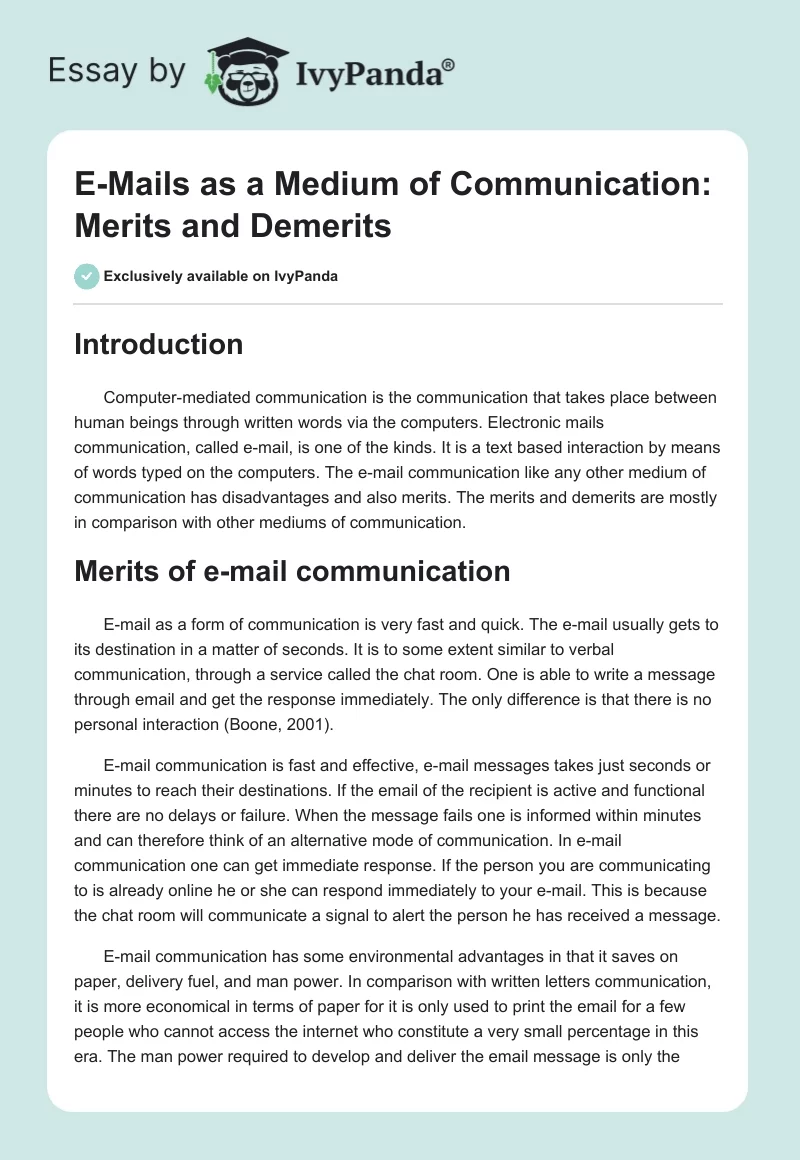Introduction
Computer-mediated communication is the communication that takes place between human beings through written words via the computers. Electronic mails communication, called e-mail, is one of the kinds. It is a text based interaction by means of words typed on the computers. The e-mail communication like any other medium of communication has disadvantages and also merits. The merits and demerits are mostly in comparison with other mediums of communication.
Merits of e-mail communication
E-mail as a form of communication is very fast and quick. The e-mail usually gets to its destination in a matter of seconds. It is to some extent similar to verbal communication, through a service called the chat room. One is able to write a message through email and get the response immediately. The only difference is that there is no personal interaction (Boone, 2001).
E-mail communication is fast and effective, e-mail messages takes just seconds or minutes to reach their destinations. If the email of the recipient is active and functional there are no delays or failure. When the message fails one is informed within minutes and can therefore think of an alternative mode of communication. In e-mail communication one can get immediate response. If the person you are communicating to is already online he or she can respond immediately to your e-mail. This is because the chat room will communicate a signal to alert the person he has received a message.
E-mail communication has some environmental advantages in that it saves on paper, delivery fuel, and man power. In comparison with written letters communication, it is more economical in terms of paper for it is only used to print the email for a few people who cannot access the internet who constitute a very small percentage in this era. The man power required to develop and deliver the email message is only the person typing it and may be another individual to proof read it. No fuel is needed to deliver it as per the case of letter mails also referred to as snail mails. It is a medium of communication that has the ability to send information in bulk and to multiple recipients at a low cost. One needs to attach a single document then send it to multiple addresses. For example it makes advertisement very easy and cheap compared to adverts through the paper (Habil & Rafik, 2002).
This medium of communication speeds up the decision making processes hence there is increase in productivity. It also helps in planning and preparation hence making production easier. The flexibility in working is realized as one can work from whichever location as long as he has a computer. Email breaks the barrier of distance and time of traditionally written letters and telephone calls. This is because it shortens the communication cycle especially for the written communication.
Demerits of e-mails
E-mail is not necessarily private; this is because the messages are passed from one system to another hence creating chances and opportunities for people to intercept. There are measures put in place to secure emails but it is still possible for people to bypass such security. Some systems may not be able to read or display properly the emails one receives. There is also a threat of forged email though not so common but it’s possible to do so (Habil & Rafik, 2002).
The recipient is denied the benefit of seeing your facial expression or hearing your voice; which are two components crucial in communication. One is needed to be extra careful with the way he puts across the sense of humor or sarcasm for one may be easily misunderstood. It is very easy for one to take the message wrongly and fail to understand what the writer intended. Email is limited to people who are literate and have access to internet and are computer literate. For effective communication through email, literacy is crucial.
Misunderstanding may rise due to different cultural interpretation of some words, depending on the people receiving the message. They can also interfere with the security of an organization because sensitive information can be accidentally distributed or even deliberately. This demands entrusting emails to well-trained and trusted staff members (Boone, 2001).
Conclusion
E-mail is words on the screen and takes a person with verifiable credentials to communicate emotions through writing. It’s not reliable for one can delete the messages as you receive them while others cheat that their in boxes are full hence restricted emails. E-mail is helpful and as a fact widely used but it is impersonal and unreliable. It is also an informal mode of communication.
Reference
Boone, C. K. (2001). Speech or writing? E-mail as a New Medium; liberal Education, vol. 87. Web.
Habil, H., & Rafik, S. (2002). The dynamics of electronic mail as a communication medium. paper presented at the IT and UNIVERSITIES OF ASIA INTERNATIONAL CONFERENCE, Chilalongkon University, Bangkok, Thailand. Web.


